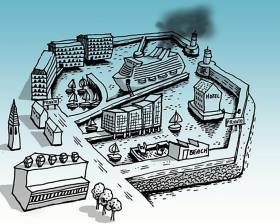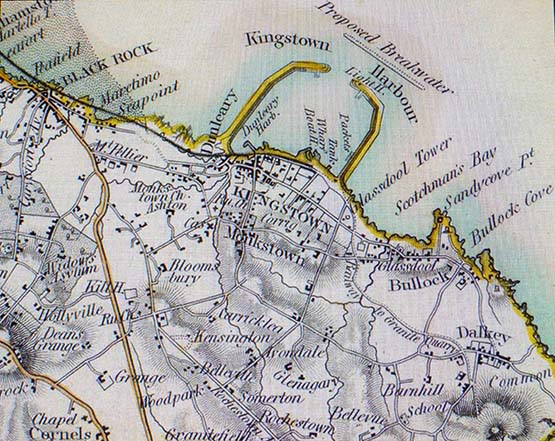Displaying items by tag: Richard Boyd Barrett
With An Bord Pleanala due to give its decision on permission for a giant cruise liner berth in Dun Laoghaire Harbour in the coming weeks after almost a year of delays, the Save Our Seafront movement is pulling out all the stops in its continuing opposition writes W M Nixon.
A Public Meeting is scheduled for the Kingstown Suite in the Royal Marine Hotel on Thursday 27th October at 7.00pm, and speakers including Richard Boyd Barrett TD and Cllr Melissa Halpin will outline the two main options for the Government as the SOS movement sees it.
According to SOS, Minister for Transport Shane Ross - in conjunction with Dun Laoghaire Rathdown County Council - will have to choose between trying to continue with the existing Harbour Company as a commercial quango only nominally under the control of the council, or alternatively they can choose to dissolve the Harbour Company and bring the harbour under the full democratic control of the Council.
Save Our Seafront are totally in favour of the second option, and in support of this, they have issued a very hard-hitting statement giving detailed criticism of many aspects of the administration of the Harbour Company.
Looking to the future, they hope to see Dun Laoghaire Harbour moving forward with the establishment of a public national watersports centre and a Diaspora Museum, with the harbour protected as a fully public amenity accessible to all.
 Dun Laoghaire Harbour as it is today, with an attractive mix of fully sheltered berthing and semi-sheltered sailing space ideal for training, fresh air and a mood of spiritual uplift. Photo: Peter Barrow
Dun Laoghaire Harbour as it is today, with an attractive mix of fully sheltered berthing and semi-sheltered sailing space ideal for training, fresh air and a mood of spiritual uplift. Photo: Peter Barrow
An Bord Pleanala is currently in process of hearing submissions - for and against - about the future of a proposed superliner berth in Dun Laoghaire which would change the harbour out of all recognition for recreational purposes, but could provide Dun Laoghaire Harbour Company with a new income stream, though only after massive investment.
Meanwhile, Dun Laoghaire/Rathdown County Council agreed on October 22nd in a requirement of their Development Plan that the harbour – which they will control in the future if proposed legislation can be completed and put in place – will be limited to berthing liners of not more than 250 metres in length. W M Nixon returns this morning to the continuing saga of Dun Laoghaire Harbour’s future.
It was only a snippet of news in the stream of maritime information which pours steadily through the Afloat.ie website, no more than a Tweet from Cllr Melissa Halpin on October 22nd confirming the 250 metre length limit’s approval. She was responding to Afloat’s review of ideas in an Opinion piece in The Irish Times by Dermot Reidy of Dun Laoghaire Combined Clubs, an active umbrella group which has put forward a detailed submission to An Bord Pleanala. And the DLCC’s proposals, as Councillor Victor Boyhan was delighted to report yesterday, also received the full support of the Council at their weekly meeting, this time on Thursday, October 29th. [see webcast of Special Meeting of the County Council on the Development Plan here – Ed]
The oral hearing will resume for its final public session on Monday 2nd November after taking a week’s break from October 23rd following the hearing of detailed submissions from many sources since October 14th. But it was typical of the way that so many organisations are involved – or would wish to be involved – in the future of Dun Laoghaire Harbour, that even as An Bord Pleanala was still taking evidence, the local council finally responded to the growing pressure from the Save Our Seafront group led by local politicians such as Richard Boyd Barrett TD and Cllrs Melissa Halpin and Victor Boyhan, and considered a motion to restrict the size of cruise liners which will be allowed to use Dun Laoghaire Harbour in the future.
It could be that it’s only a straw in the wind, for as Richard Boyd Barrett so tellingly explained to the hugely-significant protest meeting in the Kingston Hotel on September 7th, while there is a Government aspiration to transfer control of the administration of Dun Laoghaire Harbour to the local council, various legislative sleights-of-hand and some political and business manoeuvrings could still mean that in the end, the Dun Laoghaire Harbour Company’s commercial imperatives – real or imagined – could be the final controller of the agenda, with Dun Laoghaire/Rathdown County Council only in titular control.
Nevertheless, the DL/RCC’s new Development Plan’s inclusion of the stipulation that cruise liners coming to the harbour should not exceed 250 metres in length is a huge improvement on the unlovely 360 metre floating tenements which are currently envisaged in the Harbour Company’s plan. And when we actually get around to considering the sort of ship this will involve, and how she can be accommodated at a re-configured version of either St Michael’s Wharf or Carlisle Pier without any intrusive new structures in mid-harbour, then we realize we are indeed looking at something hopeful.

Photo imaging of a maxi-size 360 metre cruise liner in the proposed berth in mid-harbour in Dun Laoghaire, which would involved building a new 435 metre pier jutting far into what is currently clear water.
There are many 250 metre modern high quality cruise liners afloat today, and they occupy a sweet part of the upper end niche market which would provide the possibility of bringing Dun Laoghaire the kind of discerning cruise line passengers who might do the local economy a bit of real good over and above the basic income paid to the Harbour Company as berthing fees.
But by contrast, in the case of a giant liner of 360 metres, the berthing fees are pretty much the only income that will accrue to the local economy, as tenement cruise liner folk are not big spenders ashore, in fact many of them plan to do their entire cruise without spending one cent extra on the money they laid out to buy their ticket in the first place.
Such giant ships can be comfortably, conveniently and economically accommodated in Dublin Port, where the European Development Bank has just approved a €100 million loan to further develop the giant cruise liner berthing. All of which makes it even more absurd that Dun Laoghaire Harbour Company should be thinking of hunting in the same over-fished pool, when there is a different and well-stocked pool for which their harbour and town’s unique appeal will provide a juicy and successful bait.
And on top of that, for our maritime enthusiasts, setting the length limit at 250 metres is something very special, for it takes us right into consideration of one of the finest ships ever built in Ireland - the wonderful Canberra, the last and possibly the greatest ocean liner ever built by Harland & Wolff in Belfast. She may have been launched as long ago as 1958 – on St Patrick’s Day, no less – yet although she ended her active and very varied career in 1997, she still looks as modern as tomorrow, and her handy overall length of 250 metres – 820ft since you ask – made her ideal for a cruise liner to interesting places after she’d been taken off her original route from London to Australia.
The Canberra
She also served as a troopship in the Falklands War of 1982, where her duties included a visit to South Georgia where she would have been anchored close to Sir Ernest Shackleton’s grave. But eventually, after many years of further popular service as a cruise liner, for all that much of her technology was way ahead of its time, the poor old Canberra just got worn out, for she’d been busy since the day she left Belfast Lough – and in 1997 she was sold to Pakistan to be scrapped on the beach, which she resisted to the end – the word is this unique vessel took an awful lot of breaking up.

The hard life. Canberra in South Georgia while on troopship duties during the Falklands war of 1982
Invitably, modern 250 metre cruise liners do not quite have the timless elegance of the Canberra, as accountants and financial officers rule their concept as much as naval architects. But nevertheless they are of a more comprehensible and manageable size than the excessive 360 metre behemoths which would destroy the character of Dun Laoghaire Harbour, and provided the Harbour Master felt it could be done without impairing the basic character of the harbour, I feel we should be at least receptive to the idea of 250 metre vessels coming in, for it’s a huge step for the County Council to have made the decision to set this size limit.
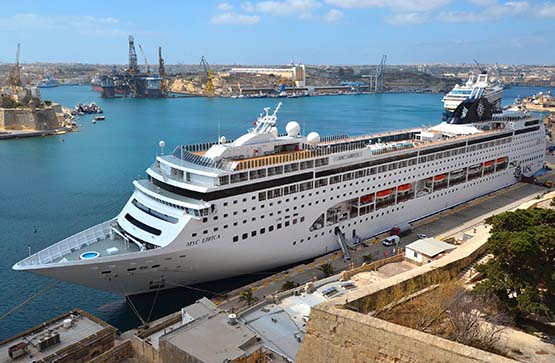
The Lirica is a modern 250 metre cruise liner, and although obviously more voluminous than Canberra, nevertheless it is possible that she could be berthed in Dun Laoghaire without massive waterfront infrastructural change being required.
Meanwhile, the battle goes on to try and create a truly meaningful relationship between Dun Laoghaire township and its harbour, for as we’ve pointed out here before, when they started planning an Asylum Harbour back in the early 1800s, it was moved forward primarily by considerations of facilitating government power and function, and there was no real consideration of the requirements of ordinary mortals.
Thus the most basic initial thinking behind the new harbour was that it could provide refuge when required for troopships and naval vessels. So no thought whatever was given to the notion that personnel on board such vessels should have any contact with the shore, which at that time was virtually empty in any case, as the only local settlement of any kind, the little harbour of Dun Leary, was seen as being outside and irrelevant to the new harbour.
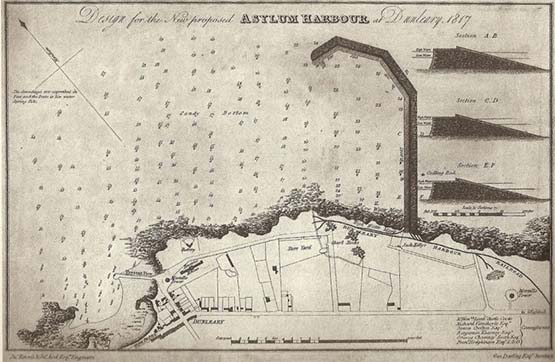
The beginnings. The initial plan for the new Asylum Harbour was a singe pier to provide protection from southeasterlies. It was well to the east of the little local port of Dun Leary, and a new road – ultimately George’s Street - was sketched in through uninhabited countryside to take travellers direct from Dunleary to the next local village of Dalkey while keeping them at some distance from the new harbour
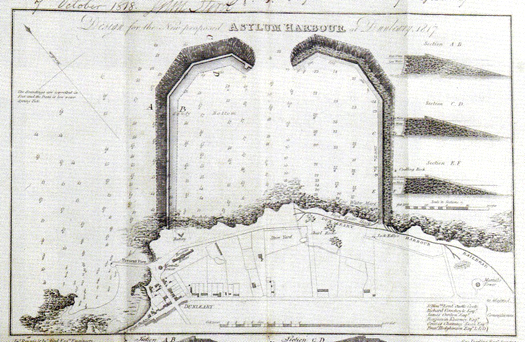
A second plan for the new harbour included a west pier, but it still excluded Dunleary itself.
But as the new harbour took shape, superbly constructed in Dalkey granite to be a sort of “instant historic monument”, inevitably shoreside development took place as well. After the place had been named Kingstown following a Royal Visit in 1821, it got notions of itself as a fashionable resort. But it was a case of every man for himself in the matter of development, and as one scathing critic wrote of in the 1850s, “ no system whatever has been observed in laying out the town so that it has an irregular, republican air of dirt and independence, no man heeding his neighbour’s pleasure, and uncouth structures in absurd situations offending the eye at every turn”.
Kingstown and its harbour around 1870, with a proposed breakwater (never built) off the entrance to provide added shelter from nor’easterlies. The railway still only reached halfway along the waterfront, and the Carlisle Pier had yet to be built, with the cross-channel packet boats having to make do with a berth on the East Pier.
Could that possibly be our own dear Dun Laoghaire? That reference to a “republican air of dirt and independence” was particularly hurtful to a place which prided itself on being called Kingstown, but that’s the way it was and still is, for the fact of the matter is that while the town and harbour have developed side by side, they have never developed together.
Thus there are enormous blind spots to the interests of others. The new library may look not too bad at all from the landward side, but from the harbour it is hideous. As for the endless struggle to make George’s Street back into a successful retail shopping venue, no matter what they do it still seems to slip further down the decline, and the recent plan to sub-divide it into quarters devoted to different area of shopping interest made no reference at all to the potential of the nearby presence of the harbour, for apparently that had not been in the consultants’ brief.
As for paying for the running of the harbour, we recently got an old friend, an accountant with a maritime outlook and extensive experience in many countries, to take a look at Dun Laoghaire in its totality and how the harbour might be funded, and he concluded that trying to find out how much it actually costs to run the harbour in some sort of relationship with the town would be like being eternally condemned to peeling an onion, as one layer removed would only reveal another, and you’d ultimately be reduced to tears.
That said, he did make us sit up and take notice by suggesting that they’re wasting their time trying to revive George’s Street as a shopping venue – instead, they should think in terms of letting it become residential with some offices in a setup which would thereby encourage a few thriving local shops at strategic intervals, rather than trying to have a whole row of under-utilised shops in terminal decline with the street’s decreasing footfall.

The Carlisle Pier in its glory days, when it was possible to get into a train in Sligo and travel all the way to London without being exposed to the rain at any stage. And of course, there was no question of spending any money in Kingstown……
Today, people talk about the situation of Dun Laoghaire Harbour as if it was always the case that it was a commercial and ferry port, and that the modern administrators of the port are obliged under time-honoured traditions to show a profit. In fact, Dun Laoghaire started life as Royal Harbour serving governmental and imperial needs, and ordinary people trying to do something so vulgar as make a living and even show a modest profit had to do so under the radar.
Thus although “ferry port” is still the link which will most readily spring to public mind in relation to Dun Laoghaire, but the early ferry operators had to get by as best they could with ad hoc facilities, and even a seemingly ancient structure such as the Carlisle Pier, with its two cross-channel ferries directly serviced by the railway, was a later addition – for many years, the best the packet boats could hope for was the berth on the east pier.
So contemporary letters to the newspapers which assert that Dun Laoghaire must now develop further and pay for itself, because it would not be in being were it not for Victorian entrepreneurial flair, are actually very wide of the mark. There was nothing at all entrepreneurial and commercial about the original thinking behind the building of Dun Laoghaire Harbour. So it would be in keeping with its true character and history were it allowed to be maintained today as a sort of maritime version of the Phoenix Park.
But of course, if 250 metre cruise liners really could be slotted in without requiring drastic changes to the waterfront, then well and good. And as we came in with a discussion about the last and best ocean liner built in Belfast being 250 metres long, how’s about the most famous ocean liner ever built in Belfast? It’s said that some mysterious billionaire is having a replica of the Titanic built in China. As it happens, the original Titanic was 269 metres long. But if the new Titanic expressed an interest in berthing in Dun Laoghaire, surely those extra 19 metres could somehow be accommodated………
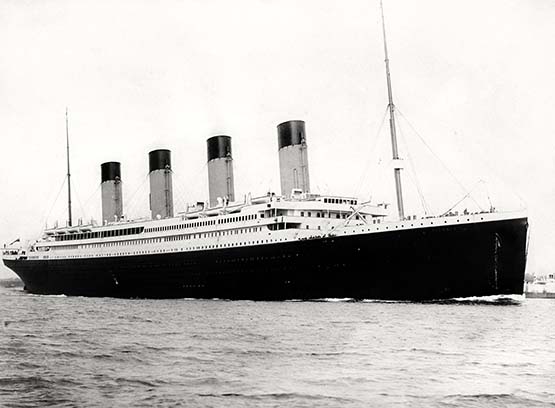
Would they allow those extra 19 metres into Dun Laoghaire? It’s rumoured that a replica of the Titanic is being built in China, but at 269 metres they’d have to stretch the regulations a little to let her into Dun Laoghaire Harbour.
#dlharbour – Hostile questions were asked in the Dail on Wednesday by local TD Richard Boyd Barrett on the proposed development of Dun Laoghaire Harbour as a cruise liner port. They were deflected in ministerial replies about legislation currently being drafted, and the two possible viable ways forward for the harbour's administration. But the underlying pace is accelerating towards a resolution of the future of this unique example of Victorian design, engineering and construction. W M Nixon finds that, in recent days and weeks, his views on the possible uses of this magnificent artificial harbour have undergone considerable change.
Embarrassment is a powerful stimulant for change. Change of attitude, change in ways in behaving, change in ways of looking at things, change to entrenched ways of thinking. I was hugely embarrassed by something seen in Dun Laoghaire nine days ago. And within seconds, there came a complete epiphany, with the sudden awareness that an entrenched attitude towards the development of Dun Laoghaire as a cruise liner port had turned through about 140 degrees.
It made for the complete 180 degrees, as the first 40 degrees of the turn had already been achieved a couple of weeks previously, while spending two completely absorbing if mentally exhausting hours with the maverick Alistair Rumball and his team at the Irish National Sailing School beside the inner recesses of Dun Laoghaire's inner harbour, which is still called the Coal Harbour even though it's very many years since anyone offloaded any lumps of the black gold there.
Be that as it may, as we parted we were shooting the breeze about the proposed development of Dun Laoghaire as a cruise liner port, which has been top of the local agenda since the end of March, and handily gave us one of our choicer April Fool's Day stories here on Afloat.ie - it proved so effective we had to add a health warning.
When a story provides you with something like that, you develop a certain affection for it. So while Alistair and I agreed that that the absolute dream solution for Dun Laoghaire Harbour would be a top-of-the-line government-funded National Monument Preservation Scheme, with the entire place given over exclusively to recreation afloat and ashore, and no commercial shipping of any significant size whatsoever allowed about the place, we knew it was pie in the sky.
"How on earth would they really pay for it?" he asked. "This place is huge, it costs a fortune to run and maintain. A cruise liner berth offers the best and most compact method of providing a worthwhile income stream. And as we in our sailing school – being a commercial operation – have to be rigorous in observing harbour regulations and keeping clear of the established in-harbour shipping lanes, we know that you can continue to sail small boats in large areas of the harbour without any undue sense of space restrictions".
Subsequently, I've been spending some time around Cork Harbour, where circumstances are so different from Dublin Bay that, unlikely as it may seem, you end up feeling sorry for the sailors of south Dublin. For while Cork is almost embarrassed by its riches in natural amenities for sailing, and it's all in a large and attractive harbour where marinas can be put down almost anywhere with no more than a floating breakwater to provide the necessary minimum of shelter, Dublin Bay by contrast is a hugely deprived area in terms of natural waterfront facilities for sailing, yet any attempts to provide man-made shoreline amenities for boats and sailors are dogged with local opposition every inch of the way.

Around Cork Harbour, it only needs a floating breakwater and, hey presto, you've suddenly got a marina - as seen here at Monkstown. Photo: W M Nixon
Thoughts of this struggle, and how things change, emerged again for various reasons in Dun Laoghaire nine days ago, at the reception in Irish Lights HQ to launch the Great Lighthouses Tourism Initiative. Time was when our many fine lighthouses were places of mystery, and permission to visit took quite a bit of arranging if it could be managed at all. But my word, times have changed. In this electronic age, there are those who wonder if we need all our lighthouses. Yet Irish Lights is legally obliged to maintain them, and the built structures around them.
So Yvonne Shields, the CEO of Irish Lights, whom we'd describe as very switched on and extremely bright were we not talking of the top executive in a lights organisation, unveiled this sensible scheme whereby twelve of our greatest lighthouses are being transformed into stations on a tourist trail, while continuing as working lighthouses.
As the greatest and most monumental lighthouses on land tend to be on rugged headlands in remote areas, in the eyes of Brussels they're in peripheral areas deserving special aid. So there's €2 million of Eurodosh going into this project, which sees what had become increasing liabilities being transformed into tourist resources. And if we're going to be sniffy about that, let's face it: the kind of tourist who'll want to visit a remote lighthouse will not be the kind of tourist who would keep you well clear of Temple Bar.
So the old grey matter was churning briskly away on the business of seeing lighthouses in a new way as we headed home past the Coal Harbour, and there it was: The Embarrassment. For this was the evening at the end of the day when the majestic and rather handsome cruise liner Queen Mary 2 was anchored off Dun Laoghaire in a near gale from the southwest which had delayed the morning's arrangements to ferry passengers ashore in the ship's own tenders to the special landing pontoon installed by the Harbour Company in the inner harbour.
By this time, they were trying to return on board, waiting patiently in a queue which ran the length of the inner pier and more as the two ship's tenders bustled the mile and a half plus out to the ship, yet still more buses turned up to disgorge more passengers, such that for a while the long length of the queue seemed to stay persistently the same.
Perhaps it's because we Irish don't do queuing that I found the entire thing acutely embarrassing to behold. And it wasn't even as if it was raining, which it well could have been. Nevertheless it struck me as being a Third World sort of scenario. Yet obviously these people were keen to visit Dun Laoghaire – most of the thousands of passengers on board had elected to go ashore.

This just won't do at all – images of Third World destinations came to mind on seeing the passengers from the Queen Mary 3 queuing in the Coal Harbour in Dun Laoghaire to get back out to their ship anchored in the bay. Photo: W M Nixon
So the epiphany came with the essential flashing great light. If we're going to have cruise liners calling at Dun Laoghaire, boomed this disembodied voice, then let's do it properly and provide them with a proper berth. Otherwise, don't have them about the place at all. But please, please – no more buzzing in and out in little tenders in this Irish climate, and no more queuing on a comfortless pier. It's an affront to our best traditions of hospitality.
This sudden firing-up with all the zeal of the recent convert (for until then, I'd wanted Dun Laoghaire to stay exactly as it is, and damn the expense) resulted in my being right into the dragon's den four days later. It was meant to be a short and businesslike meeting with Gerry Dunne, the CEO of Dun Laoghaire Harbour Company, to discuss the Cruise Liner Berth Proposals. But so many ideas were flying around that we ran well over time.
Please be assured, though, that I did my best to represent the needs of the boat-owning and sailing community while accepting that since Stena Sealink withdrew from running a ferry service from Dun Laoghaire to Holyhead, something very serious indeed needs to be done to pay for the maintenance of the harbour.
We have to remember that, among Ireland's main sailing centres, Cork and Kinsale are blessed with such good natural harbours that any marinas located in either harbour do not need fixed breakwaters. As for Bangor Marina on Belfast Lough, it may need a very substantial solid breakwater on its north side, but otherwise - thanks to being located in a bay - three of its four sides are naturally sheltered. But Dun Laoghaire is badly done by – it's so totally an artificial harbour in an exposed location that three of its four sides are protected by large man-made breakwaters, and while they are constructed in monumental style, continuous monitoring and maintenance is essential.
This is costly, but it would become even more so were standards allowed to slip for even a year or two. Even with the present high standards, there can be underlying wear and tear which in time needs major capital expenditure, and according to one recent report, hidden erosion on the most exposed section of the East Pier may eventually need up to €5 million for a proper remedial job.
As it is, the current basic running costs of the harbour are between €2 and €2.5 million a year. Were it kept as a purely recreational harbour and general public amenity, this figure could perhaps be slightly reduced. Yet the Dun Laoghaire recreational boating market still could not withstand paying the full amount out of its own resources and expected annual expenditure, so the shortfall would have to be made up by Government subvention.
But would the sailing and boating people of Dun Laoghaire really like to feel that they're beholden to taxpayers throughout Ireland for their continuing enjoyment of this wonderful amenity at affordable prices? There's something unpleasantly artificial about the idea of such an arrangement, whereas a harbour which is providing a modest but genuine profit is something which has a much healthier feel to it.
Surely if a way can be found of generating a worthwhile income stream without unduly distorting the traditional functioning of the harbour, then that idea should at the very least be actively explored, and recreational boating groups should be prepared to reach out towards compromises in the knowledge that, in turn, such arrangements would make the Harbour Company more accountable to all.
However, local representative Richard Boyd Barrett TD of the People Before Profit party, and Chair of Dun Laoghaire Save Our Seafront Group, sees it differently, and he has called for "a major campaign of people power against the planned cruise berth, and to protect the future of the harbour as a public amenity". His three main objections to a cruise berth plan are "(1) That the cost and financing of the project at €18 million means that the Harbour Company will have to borrow using its existing assets, where no proper business case has been produced. This puts the very future of the harbour at risk. (2) The entire plan has been hatched by an unelected board of the Harbour Company, Council Executives, and local business people who ran a sham of a public consultation over the two weeks of the Easter Holidays, and (3) The scale of the luxury liners at 300 metres long and 59 metres high will dwarf the harbour and reduce public access and public enjoyment of the most intact Victorian harbour in Britain and Ireland".
So with a Harbour Company which is government-owned, yet is charged with maximizing the economic benefit and exploiting the commercial opportunities provided by Dun Laoghaire Harbour, clearly there is something of a divide between the two sides. In fact, "light years apart" just about sums it up.
Nevertheless, politics being the art of the possible, it has to be possible to bring people together sufficiently to see that perhaps a proper sympathetically-designed cruise liner berth might indeed be the answer. After all, although it was built between 1817 and 1842 purely as a harbour of refuge for sailing ships with no thought of any interaction between sea and land, it very quickly became a ferry port for cross-channel steamships. At the height of this activity, with frequent roll-on roll-off ferries and their unpleasant shoreside traffic dominating the waterfront, Dun Laoghaire had lost much of its charm.
For the life of me I can't see that the much more limited shoreside traffic generated by the visits of cruise liners in the summer months can be seen as being anything like as obnoxious as the previous waves of road and rail traffic for the ferries, which was readily tolerated, and helped to keep the place going for 180 years.
And in any case, with the end of the ferry services, Dun Laoghaire definitely lacks purpose. In the Irish climate, it is very difficult to maintain a sense of vitality around a harbour which is purely devoted to personal recreation, whether afloat and ashore. It could be argued that, regardless of the economic benefits, it would be good for the mental spirit and communal well-being of Dun Laoghaire to be a cruise liner port of call, as a cruise liner strikes a neat balance between work and play. Like it or not, all work and no play may make Jack a dull boy, but all play and no work makes him mad.
But even if we accept that the shoreside traffic will be much less than it was with the regular ferries even if there is a cruise liner in port every other day, that is only part of the equation. How does the town itself shape up as a desirable cruise liner destination?
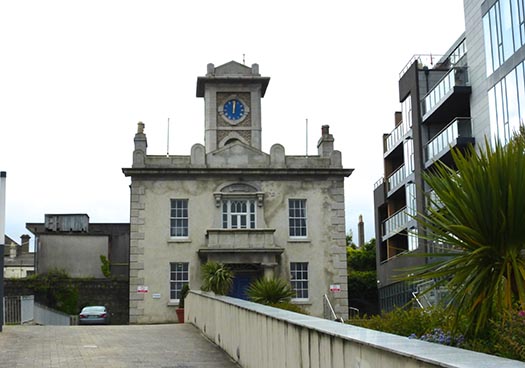
The Harbour Lodge is symbolic of today's Dun Laoghaire, a classical building from an earlier age, but now enclosed by modernity. Photo: W M Nixon
When we get down to the nitty gritty like this, Gerry Dunne is in his element. He's an affable guy, and good company, but I wouldn't like to get into a row with him, as there's steel underneath it all. So in the sedate setting of Harbour Lodge – which he cheerfully admits his opponents and friends have nick-named "Mussolini's Palace" – he's just the man to fight off the brickbats and work his way towards several objectives. But although he actually lives in Dun Laoghaire within walking distance of his office, he's not really into boat and water sports, yet that's no drawback, as personal preferences definitely don't come into it at all as he plans the way ahead.
He makes no bones about admitting that his attitude is strongly commercial. Before taking over the reins at Dun Laoghaire Harbour Company, he was Commercial Director at RTE, a job description which boggles the mind. Before that, he honed his skills in the UK, working for several large Irish food companies. If that gives you a vision of ditzy little artisan cheeses selling in agreeable country shops, then perish the thought – the big Irish food industries provide as tough a business environment as you could imagine.

The many moods of Gerry Dunne.Toughened by a varied and demanding career in business and marketing, he has brought a fresh mind to the problems of making Dun Laoghaire harbour economically viable. Photos: W M Nixon
He joined the Harbour Company in 2009, when talk of Stena's withdrawal was already in the wind. So he got Dun Laoghaire moving towards the cruise liner market in a small way, with the miniature 53-passenger Quest in 2011. Finding Quest an in-harbour berth was no problem, and she provided invaluable information on what Dun Laoghaire can provide as a USP for discerning cruise liner passengers. For Quest's rather specialist group, it was the easy access to the Wicklow Hills and particularly Mount Ussher Gardens, and they definitely didn't want to have to travel through Dublin City to get there.

The mini liner Quest – seen here in the Arctic - began the programme of attracting cruise ships to Dun Laoghaire in 2011
So far so good, but Gerry Dunne really struck gold when he started going to the cruise liner fairs in America and Europe. Gradually he built up a useful network, and again he struck gold when he got a report on the potential attractions of Dun Laoghaire from the Vice President (Itineraries) of one of the biggest American cruise liner conglomerates. Asked to sum up in one word the attraction of the Dun Laoghaire for visitors coming in from sea, her answer was: "Serenity".
We've become accustomed to Venice being talked of as The Most Serene Republic - The Serenissima. But it makes you sit up and take notice to hear of Dun Laoghaire being so described by a tough American businesswoman. Yet that's the impression the waterfront area, with its combination of the old yacht clubs, the station, the Town Hall and the Royal Marine Hotel, apparently makes on seaborn visitors from cruise liners, even if their liners are at present anchored outside the harbour and they have to be ferried in to land by ship's tenders. It seems they can blank out the less attractive buildings, and are left with the abiding impression of relaxed elegance with an easygoing way of life.
This takes a bit of getting used to, as it's so much at variance with the perception in Ireland of Dun Laoghaire as a place where they'd argue over anything and everything all the time, while just up the street there's the real problem of the dreary array of boarded-up shops. But like it or lump it, here it is folks – the reality is the yacht clubs and other other historically significant and stylish buildings of the Dun Laoghaire waterfront area – including the pleasantly under-stated Victorian residential terraces - are the town's greatest tourist asset.
Quite what some of the more senior members of the yacht clubs will make of that we can only guess, but the word is that the clubs have indicated that they'll be prepared to welcome some cruiser liner guests to their premises at pre-arranged times. So perhaps we should see the cruise liners as no more than extra-super super yachts......And there's no doubt that many rugged sailing folk from Dun Laoghaire are themselves only too happy to tootle off on a cruise liner when the peak of the sailing season is over.
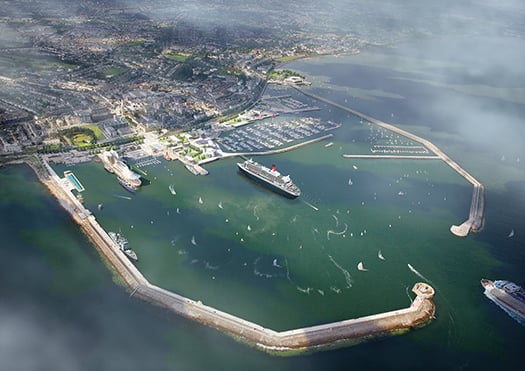
The artist's impression was just that – an artist's impression. If the new berth goes ahead, cruise liners will actually have their sterns towards the town.
But what is the reality if the new berth is agreed? Well, you can forget about your artist's impressions showing a liner facing the town. Space will be restricted, so the liners will come in stern first, thereby enabling them to make an elegant departure for the benefit of crowds down the end of the piers, which could become a popular occurrence.
The new liner pier will be as short as possible, though it will have an underpass for small craft, while the bows of the ships themselves will be held in place by dolphins, as was the HSS ferry. If you think that getting into this berth will involve impossibly ticklish manoeuvring, consider this recent photo of the three Cunard Queens up close and friendly in Southampton, and note that there's no lack of small craft nipping about among them.
 The three Cunarders can manoeuvre unaided at close quarters even with several small craft nipping about their heels, as seen here in Southampton
The three Cunarders can manoeuvre unaided at close quarters even with several small craft nipping about their heels, as seen here in Southampton
One of the other drawbacks about the current setup, with the ships anchoring off and people disembarking in the Coal Harbour, is that there's very little space for buses to move about, but the present waterfront marshalling yard left behind by the exit of Sealink will greatly relieve that problem if the new berth is built. At the moment, it is planned that passengers will walk the short length of the pier to reach their buses, but my own feeling is that the pier should be made a bit wider with a turning circle in order that passengers may board their buses almost directly from the ship, for we're not talking long distance athletes here.
That said, those who are fitter can come and go as they please, with the town within easy reach, whereas being anchored off can cause cabin fever. In other words, if Dun Laoghaire is going to have a cruise liner berth, let it be done properly – half measures involving long walks to buses just won't do, but equally for those who do walk, the town must feel accessible and welcoming.
As to the amount of space the ship will take up in the harbour, that will vary from ship to ship, but some are indeed enormous. And their wind-deflecting presence will certainly add an extra interest to in-harbour dinghy racing. As for the interest of the in-harbour racing for the visitors on the ship, that in turn will all be part of Dun Laoghaire's colourful charm, for which their ship will provide a grandstand view.
In line with that, we should remember that the leading in-harbour class, the historic Water Wags, have only just returned from showing themselves off at Morbihan Sailing week in France. Thus they'll scarcely be unduly bothered about providing a source of fascination for passengers on cruise liners, some of whom will probably be former dinghy racers themselves.

The Water Wags find it easy to sail freely within Dun Laoghaire Marina on their way out to race in the main harbour, so their only problem with a cruise liner berthed in mid-harbour will be the effect it has on wind flow. Photo: W M Nixon
But what the in-harbour dinghy racers are already becoming happily accustomed to is the newly-emptied eastern half of the harbour, with space now provided where boats used to moor. And this area will not be at risk from maneuvering cruise liners – there's not the depth for them. Finally, as to the height or otherwise of the ships in relation to other structures in Dun Laoghaire, I think we've been righteously indignant about this on a mistaken premise – since the new library was pushed into place, all bets about skyline heights and an elegant relationship with other waterfront buildings are clearly off.
So if the sailing and boating community can be more accepting of the cruise liners which will ultimately provide a real source of income to maintain the harbour which makes their activities possible, what can they expect in return?
They're in a strong negotiating position. After all, the Harbour Company's research has shown it is the comfortable presence of the yacht clubs which underpins this vision of serenity which is Dun Laoghaire's most appealing attraction for the kind of people who enjoy the cruise liner experience. So it's very much in the Harbour Company's interest to keep the clubs in good health.
By today's standards, the Royal Irish YC is thriving, thanks in no small part to its location within the marina against whose creation, ironically, the club fought tooth and nail. But the other three clubs – the Royal St George, the National, and the Dun Laoghaire MYC – are blighted by the limited and relatively unsheltered pontoon berthing at their clubhouses.
It may well be – and I'm only guessing – that the Marina Company's agreement with the Harbour Company includes a clause that these three clubs are not allowed to have their own adjacent marinas. But if such a clause exists, then it should be deleted for the greater good of the harbour and the vitality of the waterfront in general, and the three clubs should be facilitated in providing 150-boat marinas – with proper breakwaters for the George and National - in front of each clubhouse.

Dun Laoghaire from the southeast. If the new cruise liner berth is installed at mid-harbour, a longterm plan could be the installation of breakwaters in front of the Royal St George YC and the National YC in the foreground to shelter two new 150-boat marinas, as the location of the Royal Irish YC within the main marina gives it an unfair advantage in providing facilities for its members.
As to how Dun Laoghaire town can benefit, that's another matter altogether. The much stronger income and improved employment going through the Harbour Company will undoubtedly be a tangible good, though how seasonal it will be – with liners expected only between April and October – remains to be seen.
But personal expenditure by cruise liner passengers in the town is an imponderable. In fact, some cruise liners in the popular sunshine destinations are notorious for disembarking guests who feel that they made their total investment with the purchase of the ticket back home, so they don't plan to spend any more.
The historic little Venetian city-port of Dubrovnik on the Adriatic – which doesn't have a proper liner port – recently banned cruise liners from coming anywhere near the place, as their thousands of passengers made the narrow streets very uncomfortably crammed at peak times, yet the average expenditure ashore in Dubrovnik by each cruise liner passenger was precisely €6. There's food for thought. But we will of course get a better class of cruise liner passenger in Dun Laoghaire...
T.D.’s to Strut their Stuff in aid of Maritime Museum
The fundraiser event which is in aid of the Development Fund of the museum, is to take place this Thursday evening (8 p.m.) on 10th November, in the National Yacht Club (NYC) along the waterfront of Dun Laoghaire Harbour, close to the East Pier.
Tickets costing €20 are available from the Maritime Institute of Ireland's (M.I.I.) museum office located on the top floor of the Dun Laoghaire Shopping Centre, in local fashion shops and by contacting (01) 214 3964.
At the end of last month, the M.I.I. celebrated its 70th anniversary which was founded in 1941. To read more about the museum which is undergoing renovation and due to re-open in March 2012 click HERE and to read other news and developments visit www.mariner.ie
- National Yacht Club
- Dublin Bay News
- Maritime Institute of Ireland
- Dun Laoghaire Harbour
- M.I.I.
- Richard Boyd Barrett
- nyc
- Dun Laoghaire Harbour News
- National Maritime Museum
- East Pier Dun Laoghaire
- Irish Maritime Museum's
- Independent T.D's
- Luke 'Ming' Flanagan
- Mick Wallace
- Captain Roger's
- Irish T.D's
- Dun Laoghaire Shopping Centre
- Dun Laoghaire Waterfont
- Dublin Bay yacht clubs
Labour Manifesto Leads the Way on Irish Maritime Affairs
Fine Gael has told Afloat.ie details of its marine policy will be published in its manifesto tomorrow. If that's the case things are looking up for anyone interested in seeing Ireland develop the valuable waters that surround it.
After searching for references to 'sea', 'marine' or 'maritime' only the Labour party has so far made the only significant written commitment to the marine sector in its programme for government. Its manifesto acknowledges that Coastal Communities, Fisheries and the Marine face major challenges in the years ahead, but it is also an area of major economic potential.
Fianna Fail merely says on page 21 of its manifesto that it will ensure that 'an inter-departmental strategy is in place to improve the leisure potential of our harbours and increase marine tourism'.
The Green Party 'Renewing Ireland' document says it will promote the creation of marinas and youth and child friendly water sports to encourage activity and awareness of our maritime country. It also says Ireland will participates in the North Seas Offshore Grid Plan.
There is no reference to the marine in the Sinn Fein 'There is a Better Way' manifesto.
Four party manifestos are available to download below.
Labour's priority will be to develop Ireland as a European hub for seafood processing, which will create sustainable, value-added jobs in coastal communities.
Labour will also develop an Irish seafood strategy to grow the market profile and demand for Irish seafood products. We will support the development of sustainable aquaculture and fish farms by streamlining the licensing process and reducing, as much as possible, the associated bureaucracy. To further assist the development of the sector, responsibility for maritime policy will, as far as is practicable, be concentrated in one department.
Labour will establish a Sea Fisheries Sustainability Impact Assessment based on consultation with all major stakeholders. This report will be brought before the Dáil on an annual basis before EU fisheries negotiations commence, and will ensure that there is a regular evaluation of Irish fish stocks and the effectiveness of current policy and quotas.
Labour is open to the experience and expertise of those whose livelihoods depend on maritime activity. The Department of Agriculture, Fisheries and Food will engage in an ongoing structured consultation with industry representatives, the marine scientific community and other stakeholders to enable them to contribute to national maritime policy.
Finally, safety at sea and decent working conditions must underpin the development of the fisheries sector. Labour in government will ensure that the Irish Coast Guard has access to an Emergency Towing Vessel.
Dun Laoghaire People before Profit candidate Richard Boyd Barrett who has campaigned under a 'Save our Seafront' banner in the last council elections, is holding a meeting tomorrow night in Dun Laoghaire, the country's largest boating centre to protest against the possible 'privatisation' of the town's harbour.
We're tracking the progress of maritime affairs in the general election and posting details on afloat.ie. Whether you're a candidate or a vote please get in touch with your #ge11 marine news. Contact us via facebook, twitter or our website.



























